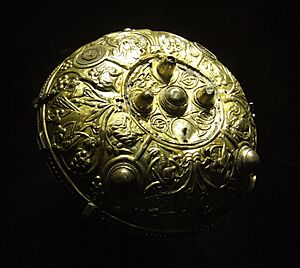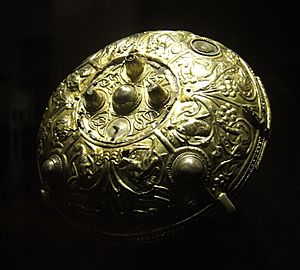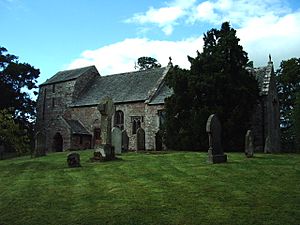Ormside bowl facts for kids
Quick facts for kids Ormside bowl |
|
|---|---|

The base of the Ormside bowl
|
|
| Material | Silver, bronze, and glass |
| Height | 45 millimetres (1.8 in) |
| Width | Diameter 138 millimetres (5.4 in) |
| Created | AD 750–800 |
| Discovered | 1823, Great Ormside, Cumbria |
| Present location | Yorkshire Museum |
| Registration | York Museums Trust - YORYM : 1990.35 |
The Ormside Bowl is a very special ancient bowl. It was made by the Anglo-Saxons around 750 to 800 AD. This beautiful bowl is made from silver, bronze, and glass. It was found in 1823 in Great Ormside, Cumbria, England. People think it might have been buried near a Viking warrior. If so, the Viking probably took the bowl from York before he died. The Ormside Bowl is one of the best examples of Anglo-Saxon silver art ever found in England.
Contents
What the Ormside Bowl Looks Like
The Ormside Bowl is actually a double-shelled cup. This means it has two layers, one inside the other. These two pieces are held together with small metal pins called rivets. The outside of the bowl is covered with amazing designs. These designs were made using a special method called repoussé. This is where the metal is pushed out from the inside to create a raised pattern. At some point, the bowl was changed to be used for drinking.
The Inside of the Bowl
The inner part of the bowl is made from bronze that has been gilded. This means it's covered with a thin layer of gold. It has small studs made of blue glass and silver. The bottom of the inner bowl has 16 round pieces of glass. These are set within a ring of tiny metal sections, called cloisons. There are also five more rivets, but the one in the middle is missing. The gold layer was added after the decorations were finished. A blue-glass stud like the ones on the bowl was found in York. This makes people think the inner bowl might have been made there.
The Outside of the Bowl
The outer part of the bowl is made from silver that has been gilded. The edge of the bowl once had a silver strip, but most of it is now gone. This strip was held on by four clips shaped like animal heads. Two of these animal heads are also missing.
The outside of the bowl is decorated with amazing Anglo-Saxon style designs. These designs show interlaced (woven together) fantasy creatures. There are also plants, grapes, fruit, animals, and birds. Some of these look real, while others are more like monsters. Another beaded band is attached to the outside rim. These attachments have square shapes, and one still has a piece of blue glass. The bottom of the outside bowl has five domed rivets. The criss-cross (cruciform) pattern between these rivets was made using the repoussé method. The bowl might also have had a small foot at the bottom, made from gilded wire.
How the Ormside Bowl Was Found
The Ormside Bowl was found in 1823. It was buried in what is now the churchyard of St James' Church in Great Ormside. It was one of the first items given to the Yorkshire Philosophical Society in 1823. Later, it became a permanent part of the Yorkshire Museum collection.
In 1898, a Viking warrior's burial was found in the same churchyard. This burial included a sword. The sword is now at the Tullie House Museum and Art Gallery in Carlisle. Some experts, like David M. Wilson, believe the bowl was actually found inside the church, not buried with the warrior. They think the bowl is too delicate to have survived being buried in the ground.
Where You Can See the Bowl
The Ormside Bowl has been shown in many places. In 1951, it was cleaned at the British Museum. It was then shown at the York Festival. It also went back to the British Museum for a short time in 1952.
In the 1980s, it was the main attraction in the Anglo-Saxon gallery at the Yorkshire Museum. It was surrounded by swords and sculptures.
The bowl was shown again at the British Museum in 2010. This was special because it was the first time a local museum had shown its collection there. After this, it returned to the Yorkshire Museum. The museum had just finished a big renovation.
From 2017, the bowl was part of a traveling exhibition called 'Viking: Rediscover the Legend'. It was shown with other famous Viking treasures. These included the Bedale Hoard and the Vale of York hoard. The tour started at the Yorkshire Museum. It then visited other places like Southport, Aberdeen, Norwich, and Nottingham.
The bowl returned to the Yorkshire Museum in September 2019. There is also a small display about the bowl at St James' Church in Great Ormside.



